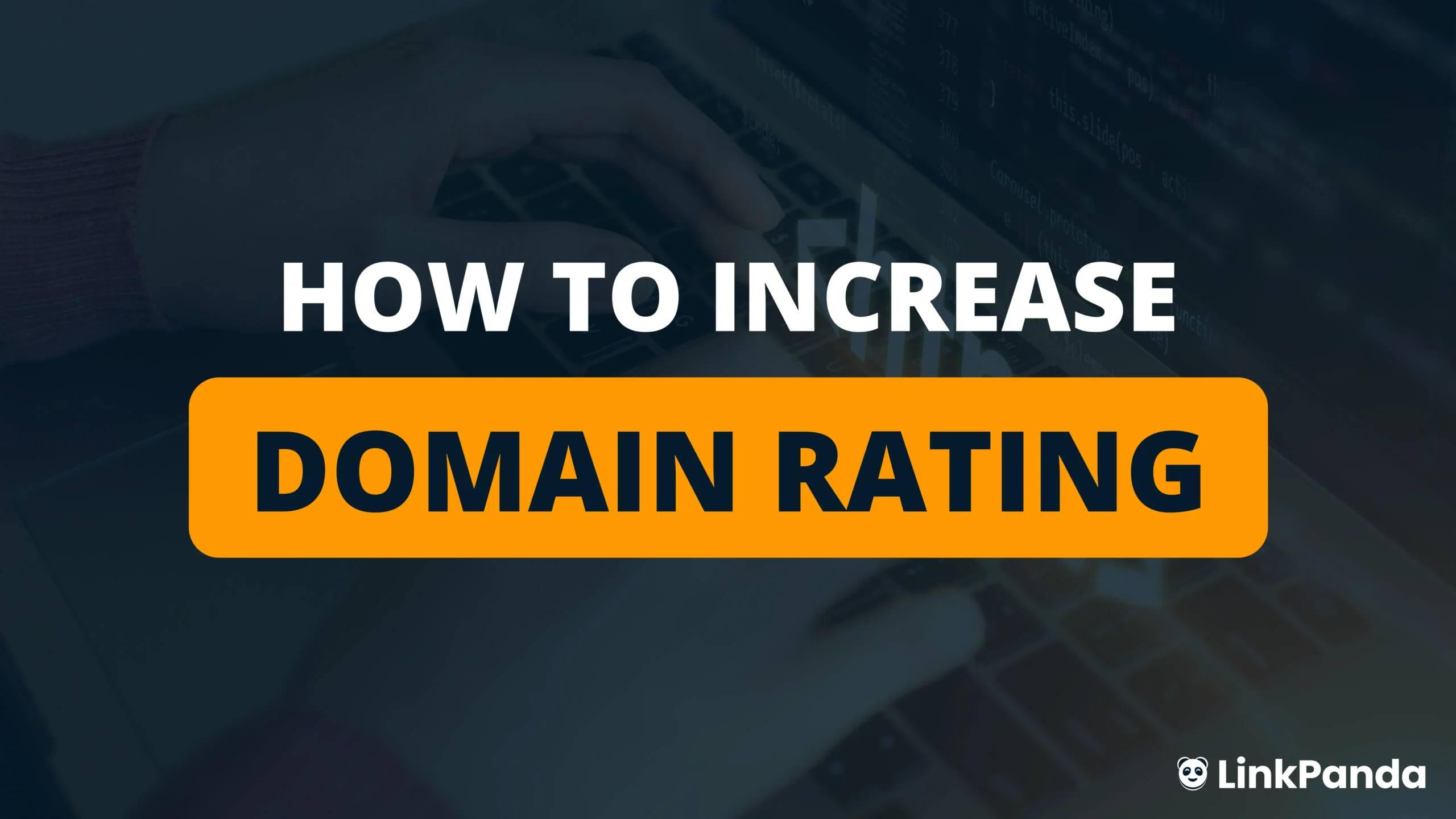Strategies for Enhanced SEO Performance
Are you finding it difficult to improve your SaaS company’s online visibility and attract quality leads? Many SaaS businesses face a standstill in search engine rankings and organic traffic due to ineffective link-building strategies. Without a strong backlink profile, your website may remain unnoticed by potential customers, while competitors gain an edge with their effective strategies.
The solution lies in implementing a targeted SaaS link-building approach tailored for companies. This strategic effort will unlock increased organic traffic and qualified leads, setting your SaaS business on the path to sustainable growth.
This blog post will showcase vital strategies for SaaS link building, which will improve your online presence and ensure sustainable business development. Discover how to implement these techniques effectively!
What is SaaS Link Building?
SaaS link building involves acquiring backlinks designed to support the unique goals of software-as-a-service businesses. It focuses on obtaining high-quality links from authoritative, industry-relevant websites to attract a targeted audience, primarily within the B2B or tech sectors. These backlinks improve search engine rankings, build credibility, showcase expertise, and support long-term customer acquisition.
Backlinks are essential for SEO in SaaS because they signal to search engines like Google that other reputable websites find your content valuable enough to link to. This is especially important for SaaS organizations, as the authority of their product or service is reinforced through backlinks.
The more a SaaS website is linked to, the more search engines view it as a trusted source, leading to higher rankings on search engine results pages (SERPs). This visibility drives organic traffic, helping SaaS companies attract potential customers and remain competitive in a challenging market.
SaaS Link Building Vs. Other Industries
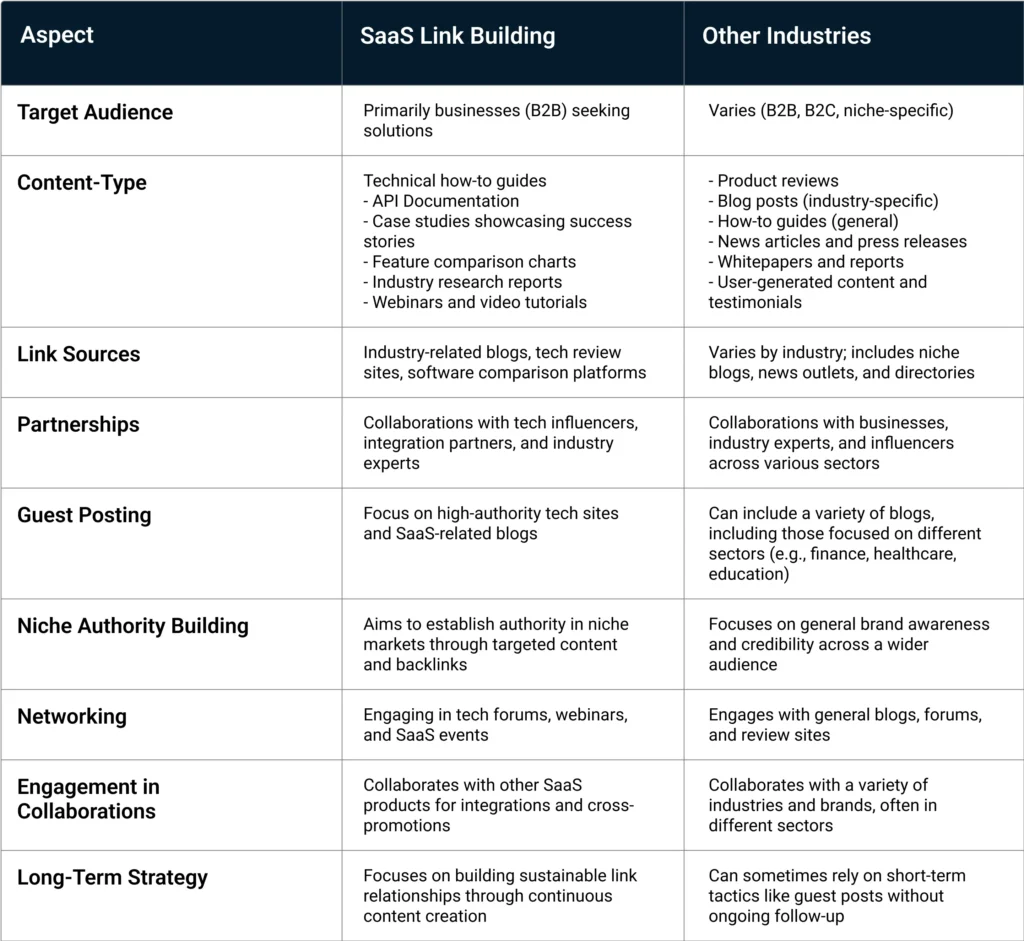
Why Invest in SaaS Link Building?
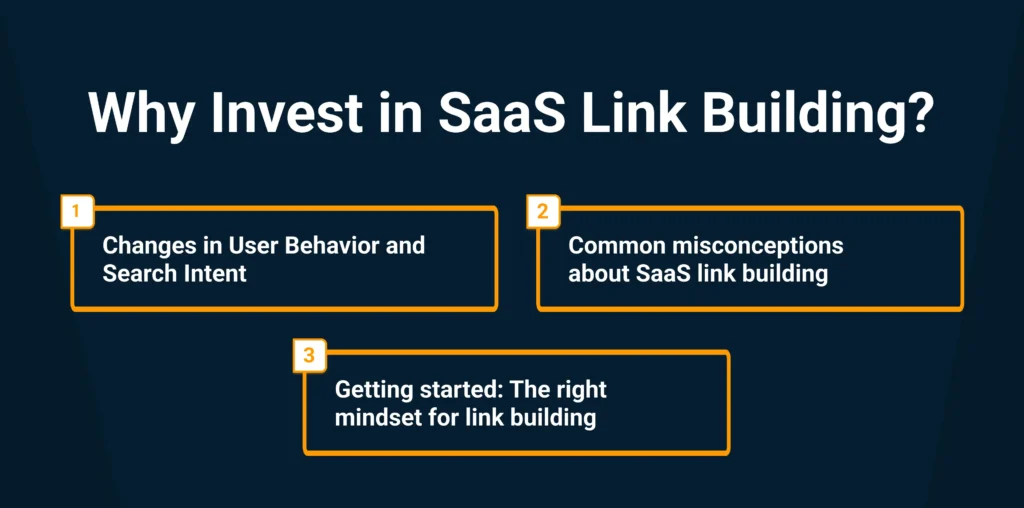
Unique benefits of effective SaaS link building
1.Enhanced Authority
Backlinks from reputable sites indicate to search engines that your content is both trustworthy and relevant. This enhances your site’s authority, leading to higher rankings in search results.
2. Increased Traffic
Each backlink acts as a pathway to your website when users click on links from trusted sources, driving referral traffic and potentially attracting new customers interested in your service.
3. Brand Recognition
Consistent exposure through backlinks on various platforms increases your brand’s visibility. This helps build trust with your audience as they encounter your brand in multiple locations.
4. Improved SEO
High-quality backlinks are a critical component of SaaS B2B SEO. They contribute to your overall SEO performance by improving your site’s credibility and visibility, making it easier for potential customers to find your SaaS solution.
5. Competitive Advantage
Effective SaaS link building allows companies to stand out from competitors. By establishing thought leadership through valuable content, you can position your brand as an authority in your niche.
Common misconceptions about SaaS link building
1.Quantity Over Quality
Having a lot of backlinks will improve their SEO. However, search engines prioritize high-quality, relevant backlinks over sheer volume.
2. Link Building is Dead
Some think link building is no longer practical due to changes in SEO practices. In reality, it remains a vital strategy for enhancing online presence.
3. Only Big Companies Benefit
There’s a misconception that only big corporations can successfully engage in SaaS link-building. Small SaaS companies can also implement effective strategies to gain valuable backlinks.
4. Instant Results
Many expect immediate traffic or ranking improvements from SaaS link building. However, this process takes time and requires consistent effort to see significant results.
Getting started: The right mindset for link building
1.Long-Term Focus
Successful link building is a steady journey, not an overnight achievement. Over time, a sustained effort is required to build meaningful connections and earn quality backlinks.
2. Value Creation
To attract natural backlinks, focus on creating high-quality, valuable content that others want to link to. This could be informative blog posts, research studies, or unique resources.
3. Relationship Building
Networking is vital. Establish relationships with industry influencers, bloggers, and other relevant sites to facilitate organic link-building.
4. Adaptability
The digital market is constantly changing. Be prepared to adapt your link-building strategies in response to new trends, algorithm updates, and shifting industry standards.
What to Avoid When Building Links for SaaS companies
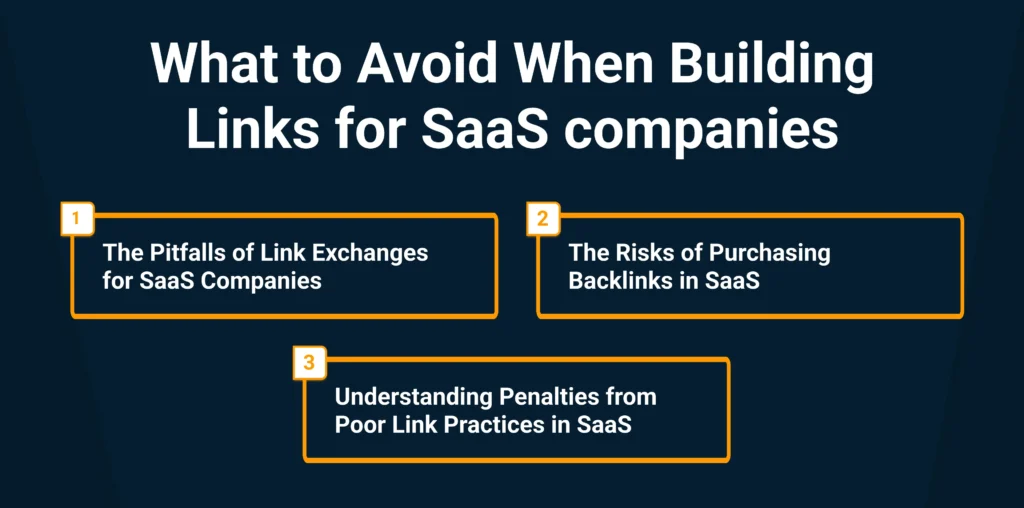
1.The Pitfalls of Link Exchanges for SaaS Companies
Link exchanges—where two websites agree to link to each other—might seem like a quick way to increase backlinks, but they can be problematic for SaaS companies. Search engines consider excessive reciprocal linking to be a manipulative strategy that may lead to negative consequences.
This practice often leads to irrelevant connections between sites, diminishing the value of those links.
2. The Risks of Purchasing Backlinks in SaaS
Buying backlinks may be a shortcut to boosting rankings, but this approach poses significant risks, especially for SaaS businesses. Purchased links are often sourced from low-quality or spammy sites, which can trigger severe search engine penalties.
These penalties might reduce visibility or even lead to a complete removal from search results. For SaaS brands, investing in organic link-building strategies ensures sustainable growth while protecting their reputation and credibility.
3. Understanding Penalties from Poor Link Practices in SaaS
Using unethical link-building practices can lead to search engine penalties, severely impacting a SaaS business. These penalties may include a drop in rankings, de-indexing, or a drastic loss in traffic.
Search engines constantly refine their algorithms to detect manipulative tactics, making it essential for SaaS companies to build links ethically. By focusing on quality and relevance, SaaS brands avoid penalties and strengthen credibility and trust with their target audience.
Types of Backlinks and Their Significance
Understanding Dofollow and Nofollow links
Dofollow Links are the standard links that pass SEO value, often called “link juice,” from one site to another. A dofollow link from a reputable website signals to search engines that your content is trustworthy and valuable.. This can improve search rankings, making dofollow links a key focus for any SEO strategy.
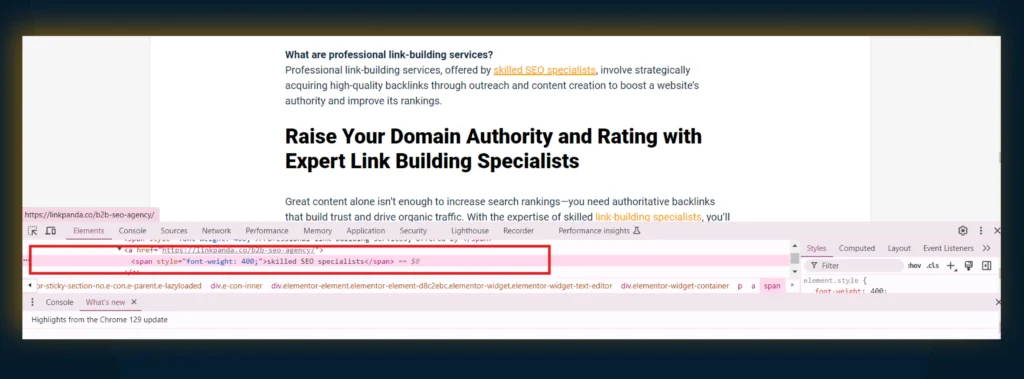
On the other hand, Nofollow Links contain a specific HTML attribute (rel=”nofollow”) that instructs search engines not to pass any SEO value through the link. These links are typically used for comments, social media posts, and sponsored content, where the site owner does not want to endorse the linked content. While nofollow links do not directly enhance search rankings, they still hold significant value in other ways.

How to Check Whether Backlinks are Nofollow or Dofollow
To determine whether a backlink is do-follow or no-follow, you can employ a few simple methods:
Browser Inspection
Right-click on the link you want to analyze and select “Inspect” or “Inspect Element” (depending on your browser).
Look for the link’s HTML code. A link is considered a nofollow link if it contains the rel=”nofollow” attribute. If there is no such attribute, it’s a dofollow link.
SEO Tools
Utilise tools like Moz, Ahrefs, or SEMrush to analyze your backlinks. These tools can provide insights into your backlink profile, indicating whether links are dofollow or nofollow, along with other valuable metrics.
Are Nofollow Links Worth Pursuing for Your SaaS Site?
The Value of Nofollow Links
Nofollow links can still be a valuable asset for your SaaS website. Here’s why:
a. Attracting High-Intent Traffic
Even though nofollow links do not pass link juice, they can drive relevant traffic to your site. A well-placed nofollow link on a reputable site can attract users genuinely interested in your services.
b. The Potential to Boost Rankings
While nofollow links don’t contribute directly to SEO value, they can increase visibility and organic traffic, which may indirectly influence your rankings. High traffic levels can signal to search engines that your content is valuable, potentially improving overall SEO performance.
c. Enhancing Social Proof
Being featured on reputable sites—even with nofollow links—can enhance your credibility. It signals to potential customers that your industry recognizes and trusts your brand.
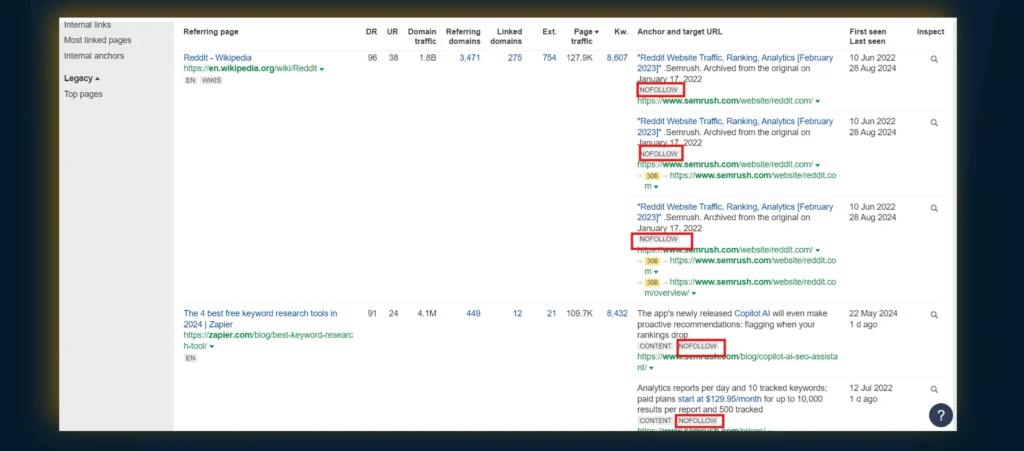
The Limitations of Nofollow Links
a. Lack of Direct SEO Value
Nofollow links do not pass link juice, meaning they won’t directly contribute to improving your search rankings. If your primary goal is to enhance your site’s authority and visibility through backlinks, focusing solely on nofollow links may not yield significant results.
b. Limited Impact on Domain Authority
Since nofollow links do not impact your site’s authority metrics like Domain Authority (DA) or Domain Rating (DR), relying heavily on them can lead to an imbalance in your backlink profile. A diverse range of both do-follow and no-follow links is generally more beneficial.
c. Potential for Misleading Analytics
Tracking the effectiveness of nofollow links can be challenging, as they don’t contribute to measurable SEO outcomes. This might make it difficult to assess the true impact of your link-building efforts and complicate your analytics.
d. Less Control Over Traffic Quality
While nofollow links can attract traffic, there is no guarantee that this traffic will convert into leads or customers. The quality of the audience can vary significantly, and visitors may not be as engaged as those coming from do-follow links on high-authority sites.
e. Risk of Overlooking Dofollow Opportunities
Focusing too much on nofollow links might distract you from pursuing valuable dofollow link opportunities. A balanced link-building strategy should prioritize links that enhance your site’s authority and credibility.
Dofollow links are essential for increasing your website’s authority and improving search engine rankings, as they pass valuable link juice directly to your site. By prioritizing do-follow links, you enhance your organic traffic and visibility, ultimately driving higher conversions and establishing a stronger market presence.
While nofollow links should play a secondary role, they can complement your strategy by enhancing brand credibility and increasing exposure. A balanced approach that emphasizes a higher proportion of do-follow links—while including some no-follow links—will create a strong link profile. This strategy not only maximizes your SEO potential but also solidifies your brand’s reputation in the industry, paving the way for sustained growth and success.
Crafting Your Outreach Strategy for SaaS Link Building
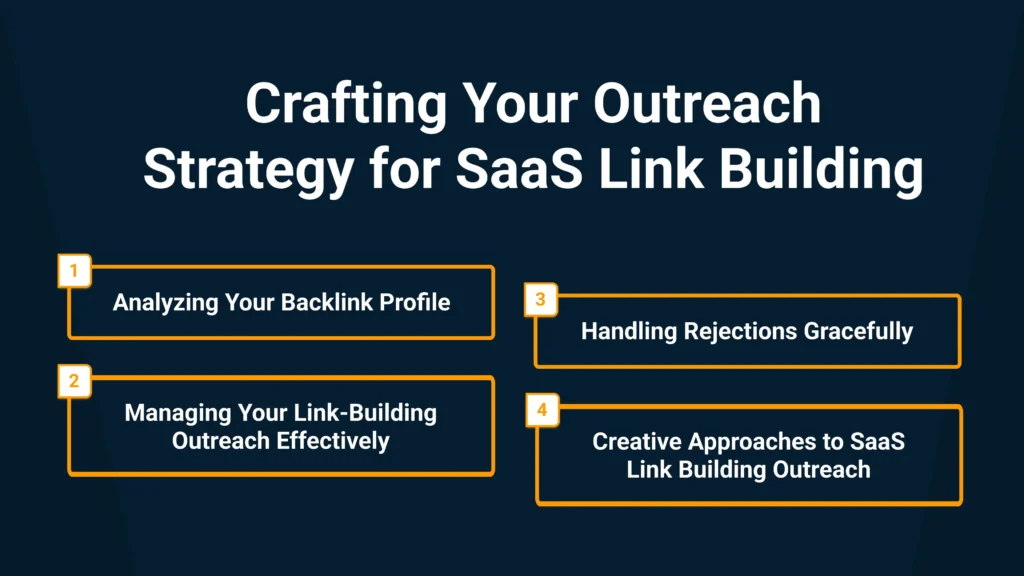
1. Analyzing Your Backlink Profile
Before launching an outreach campaign, SaaS companies must thoroughly analyze their existing backlink profile. This step is crucial for understanding their current positioning in the competitive landscape and identifying actionable insights that will directly enhance their outreach efforts, ensuring they resonate with their target audience and lead to valuable partnerships.
The Significance of Quality, Relevance, and Diversity
For SaaS businesses, the quality of their backlinks can make or break their online visibility. High-quality links from reputable technology sites, industry blogs, or influential reviewers serve as endorsements that enhance their domain authority and search engine ranking.
Conversely, high-quality backlinks can help your credibility. By identifying and cultivating high-quality links, you set a standard for the types of domains you want to approach in your outreach.
In the SaaS industry, relevance is most important; links from closely aligned sources like software review platforms, tech blogs, or industry forums are more likely to attract qualified traffic. If your analysis lacks these relevant backlinks, it’s a chance to refine your outreach toward niche-specific sites targeting your ideal customers.
Diversity in your backlink profile is also essential. Aim for a balanced mix of blogs, review sites, tech news outlets, and directories. A diverse profile boosts credibility and signals to search engines that your service is valued across various industry segments. If diversity is lacking, broaden your outreach to include different link sources.
Advanced Tools for Insights
Tools like Ahrefs, Moz, or SEMrush can provide SaaS businesses invaluable insights into their backlink profiles. These tools allow you to analyze critical metrics, such as:
a. Domain Authority (DA) and Domain Rating (DR)
Understanding the authority of linking sites helps prioritize outreach to high-DA and DR domains, which can lead to stronger backlinks and increased visibility.
b. Anchor Text Distribution
Evaluating the anchor text of your backlinks can highlight areas of over-optimization or the need for more diversity. This information is crucial for crafting natural and varied anchor text in your outreach communications.
c. Link Types
Distinguishing between do-follow and no-follow links reveals the impact of your current backlink profile. To enhance your search engine optimization, focus your outreach on securing do-follow links from authoritative sources.
2. Managing Your Link-Building Outreach Effectively
For SaaS companies, outreach is the backbone of any successful link building strategy. When managed effectively, outreach can build meaningful relationships with industry leaders, amplify brand credibility, and increase organic visibility.
Spreadsheets or Google Sheets allow you to track every outreach detail—contacts, response rates, follow-ups, and link statuses—in one place. This enhances organization and provides an easy reference to assess which approaches generate results, ensuring no opportunity is missed.
Investing in tools like BuzzStream, Pitchbox, or Hunter.io can transform the outreach process. These platforms streamline contact discovery, email tracking, and follow-up automation while providing insights into campaign performance. For SaaS companies managing multiple campaigns, these tools ensure efficient, personalized outreach at scale.
3. Handling Rejections Gracefully
Rejections are standard but can be turned into future opportunities if handled gracefully.
Always acknowledge a rejection professionally. Thanking the recipient for their time respects their decision, keeps the conversation open, and leaves a positive impression for future interactions.
Consider asking (without pressure) if there’s specific feedback on why your link request was declined. This demonstrates a genuine commitment to improvement and can provide valuable insights into audience needs or preferences you hadn’t considered.
When a link request is turned down, pivot to offer alternative value. For example, propose a content collaboration, share a relevant resource, or provide data insights. These efforts convey your dedication to meaningful exchanges beyond links and can lead to valuable partnerships.
4. Creative Approaches to SaaS Link Building Outreach
a. Experimenting with subject lines for higher engagement
The subject line of your outreach email is vital for making a solid first impression and influences whether it gets opened. Generic subject lines often get ignored. Instead, craft personalized and intriguing lines highlighting specific details about the recipient or pose an interesting question.
A/B testing can help you find what resonates best with your audience. Concise and compelling subject lines capture attention and show you’ve put thought into your outreach, increasing the likelihood of a positive response.
b. Crafting engaging questions for your Recipients
Keeping the recipient engaged once your email is opened is essential for fostering meaningful conversations in the competitive SaaS sector. Use thoughtful, open-ended questions that invite them to share insights about their offerings.
Avoid generic questions, as they often lead to brief responses. Instead, ask questions that resonate with their expertise, like, “What challenges are you facing in scaling your SaaS product?”This approach demonstrates a true understanding of their challenges and fosters a two-way conversation, making them feel appreciated and more inclined to engage.
c. Using humor to break the ice
Humor is a powerful tool in your outreach strategy, making your emails memorable and approachable. A light-hearted tone fosters positive connections and encourages engagement. However, ensure the humor aligns with the recipient’s personality and the message context. When used appropriately, humor can make your outreach feel personal and increase the likelihood of a response.
d. Customizing your outreach templates
It is essential for making a meaningful impact, even if templates can streamline the process. Reference specific details about the recipient’s SaaS products or recent initiatives.
Highlighting a feature they offer or discussing their latest blog post shows you’ve taken the time to understand their work and value their contributions. This tailored approach makes your message stand out, increasing the chances that the recipient will engage and consider your proposal seriously.
Tracking and Analyzing SaaS Link Building efforts

1. Evaluating Domain Authority and Domain Rating (DR)
Monitoring both Domain Authority (DA) and Domain Rating (DR) is vital for understanding your website’s ranking potential. Use Moz’s Link Explorer for insights into DA, while Ahrefs is excellent for evaluating DR.
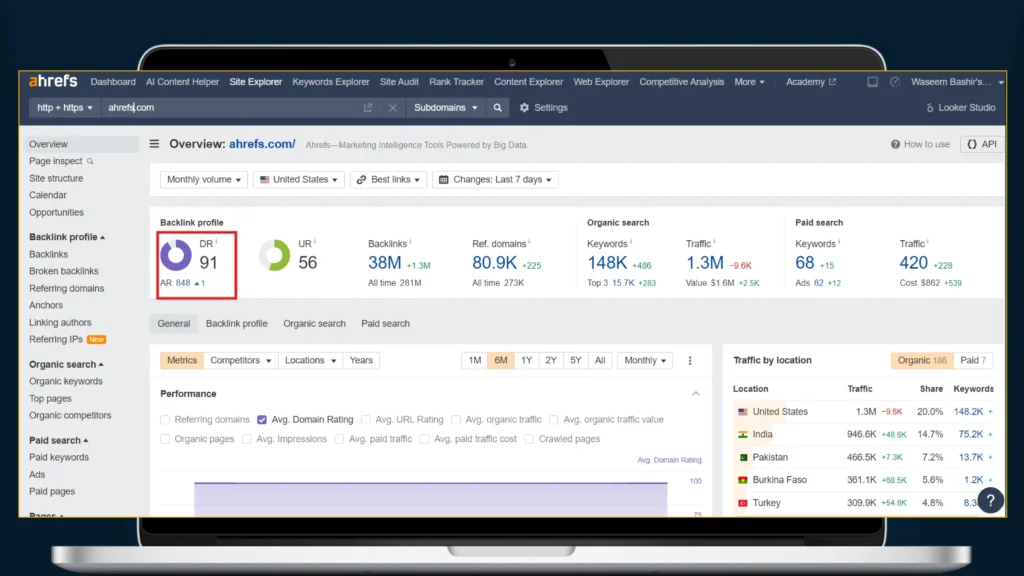
Regularly comparing these metrics with your competitors will help you identify areas for improvement. Tracking your DA and DR over time allows you to spot growth trends and set realistic targets, enabling you to refine your strategies to enhance your site’s authority in the competitive SaaS environment.
2. Analyzing Website Traffic

To effectively track user engagement on your website, use tools like Google Analytics to gain insights into visitor numbers, navigation patterns, and page duration. Complement this with heatmap tools like Hotjar and Crazy Egg, which visually show where users click and scroll, helping you identify engaging areas and refine the user experience.
High-quality content is vital for attracting and retaining visitors. Delivering insightful and relevant information encourages users to linger on your site, boosting traffic and cultivating a loyal readership. Additionally, ensuring fast loading times and mobile optimization enhances the user experience and reduces bounce rates, promoting deeper exploration of your site.
3. Assessing the Volume of Backlinks

To evaluate your backlink volume effectively, use a combination of specialized tools like Ahrefs, Moz, and SEMrush, along with strategic analysis. These platforms count backlinks while revealing their quality and relevance. Google Search Console can identify which sites link to yours and flag harmful links that may affect your rankings.
Remember, quality outweighs quantity; a few high-quality backlinks from authoritative sites can significantly enhance your SEO. Regularly tracking your backlink growth helps you spot trends, ensure progress, and quickly address any drops that could harm your rankings, making this dual focus essential for a sustainable backlink profile.
4. Click-Through Rates (CTR)
This metric measures the percentage of users who click on a link compared to those who view it, indicating the effectiveness of your link placements. A higher CTR suggests engaging and relevant links, while a low CTR signals the need for adjustments.
Important factors influencing CTR include link placement (in-content links generally perform better), the clarity of anchor text, and visual cues that attract attention. Regularly monitoring CTR with tools like Google Analytics allows for ongoing optimization of your link strategy to enhance user engagement and drive clicks.
5. Conversion Rate
This metric measures the percentage of users who take a specific action—such as signing up for a trial or subscribing—after clicking on a backlink. A higher conversion rate reflects the effectiveness of your backlinks in driving meaningful user engagement. Influenced by factors like landing page relevance, the clarity of the call to action (CTA), and overall user experience, tracking this metric through tools like Google Analytics allows for fine-tuning strategies to improve customer acquisition.
Proven Strategies for SaaS Link Building
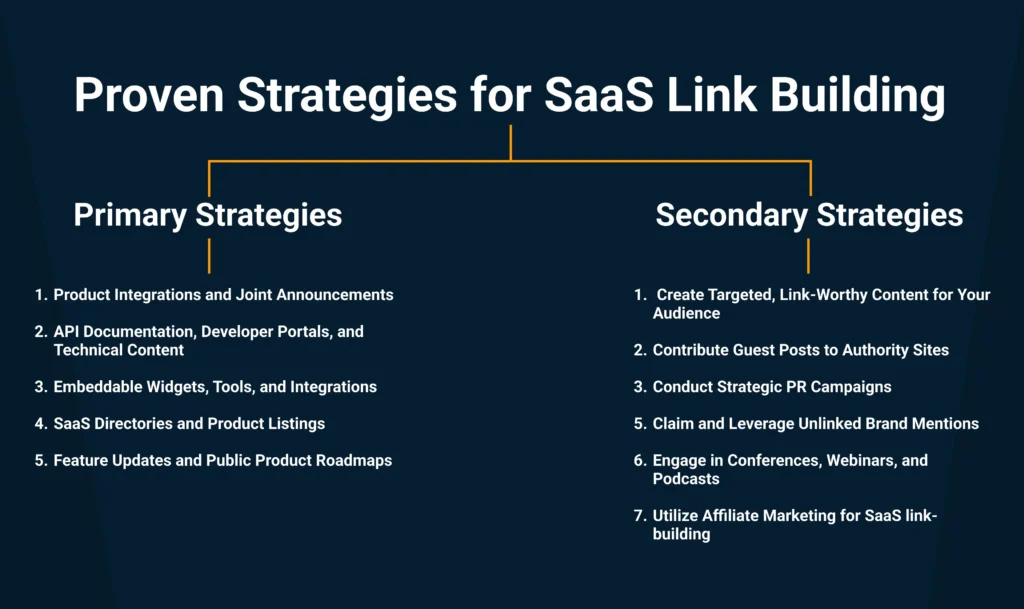
Effective SaaS link-building strategies focus on enhancing visibility and authority through various techniques. These methods enable SaaS companies to generate high-quality backlinks that improve their search engine rankings and attract targeted traffic.
Primary Strategies (Product-Centric Link Building)
1. Product Integrations and Joint Announcements
This strategy involves partnering with complementary software tools to create mutual linking opportunities. You can generate backlinks from industry blogs, tech sites, and product pages by collaborating with other SaaS brands on joint press releases or blog posts about new integrations.
This approach increases your reach as both companies promote the integration to their audiences, increasing visibility.
Ultimately, these partnerships drive organic backlinks, improve SEO, and enhance the value of both products in the eyes of potential customers.
2. API Documentation, Developer Portals, and Technical Content
This strategy focuses on creating detailed API documentation and resources for developers while ensuring that sensitive or proprietary information remains confidential.
Document public APIs intended for third-party use, and share this documentation on platforms like GitHub and Stack Overflow. Create a dedicated developer portal featuring guides, tutorials, and case studies, while avoiding sensitive information such as authentication secrets. These resources often attract backlinks from tech sites and developer blogs.
Providing high-quality technical content enhances your SaaS product’s credibility in the developer community. This leads to organic backlinks and improved SEO while protecting your proprietary information.
3. Embeddable Widgets, Tools, and Integrations
Embeddable tools and widgets create valuable opportunities for SaaS link building. By offering features that users can easily integrate into their websites, you facilitate backlinks as they reference your setup guides or documentation.
To implement this, provide an embeddable version of your SaaS product or specific functionalities, enabling partners and users to incorporate them into their resources. Each embed should link to your main product page or relevant documentation, ensuring a steady flow of backlinks from forums, partner sites, and content discussing your tools. This strategy boosts your link profile and increases visibility and engagement with your SaaS offering.
4. SaaS Directories and Product Listings
Employing third-party SaaS directories and marketplaces is a strategic approach to building SaaS link building. Listing your product in reputable directories can enhance visibility and acquire valuable backlinks.
Submit your SaaS product to trusted platforms like AWS Marketplace, Zapier’s App Directory, or niche SaaS review sites to execute this strategy. These listings provide backlinks to your main website and product pages and improve your domain authority. As these directories are well-regarded, they attract targeted traffic, increasing your product’s exposure and credibility in the market.
5. Feature Updates and Public Product Roadmaps
Highlighting your product roadmaps and feature updates is a powerful tactic for SaaS link building. By sharing this information, you can attract backlinks from industry blogs, tech forums, and community websites.
To implement this strategy, regularly publish updates on your website detailing new integrations or API improvements. Promote these updates through newsletters and relevant tech communities. This transparency encourages industry-specific publications and user forums to link to your resources, enhancing your product’s visibility and authority within the SaaS landscape.
Secondary Strategies (General Link-Building Techniques)
1. Create Targeted, Link-Worthy Content for Your Audience
Develop high-quality, evergreen content that addresses your target audience’s needs and pain points to attract organic backlinks for SaaS link building.
By producing valuable articles, in-depth guides, and research reports that are visually appealing and optimized for SEO, you can resonate with your audience and encourage links from industry blogs and related sites. This approach positions your content as a credible resource over time, enhancing your overall backlink profile.
2. Contribute Guest Posts to Authority Sites
Writing guest posts on reputable platforms enhances your SaaS link-building efforts. Identify authoritative blogs in your niche, pitch relevant topics, and include a link to your site to boost your backlink profile and establish authority.
3. Conduct Strategic PR Campaigns
Launching PR campaigns can yield valuable backlinks from news sites, especially during new feature announcements. Create engaging press releases and pitch them to media outlets to generate coverage and attract backlinks.
4. Claim and Leverage Unlinked Brand Mentions
Tracking unlinked mentions of your brand allows you to convert them into valuable backlinks for your SaaS link building. Use monitoring tools to find mentions and request site owners add links to your website, enhancing your backlink profile.
5. Engage in Conferences, Webinars, and Podcasts
Participating in industry events and discussions is a great way to generate backlinks for SaaS link building. Speaking or joining panels can also gain exposure, as event organizers often link back to your resources, increasing your brand’s authority.
6. Utilize Affiliate Marketing for SaaS link-building
Affiliate marketing is an effective strategy for strengthening SaaS link building. Affiliates create content like reviews and tutorials that drive traffic and generate high-quality backlinks. You expand your reach and credibility by partnering with affiliates who align with your brand. Each link from trusted sources boosts your SEO and positions your SaaS product as a leading solution in the market, elevating your brand’s authority and fostering community engagement.
SaaS companies can enhance their link-building efforts by focusing on primary and secondary strategies, improving search engine rankings, brand authority, and visibility in competitive markets.
FAQ’s
What is ABC link building?
ABC link exchange is a three-way linking strategy in which three websites link to each other. It enhances SEO by diversifying backlink profiles without direct reciprocal links.
How much does link building cost in SEO?
Link-building costs can range significantly from $100 to $20,000 per month, depending on the quality and quantity of links.
Is link building applicable?
Link building is essential for SEO, as it boosts a website’s ranking in search engine results pages (SERPs). Generating quality backlinks enhances the site’s authority and trustworthiness online.
What are the risks of link building?
Link-building risks include penalties from search engines for unethical practices, which can harm your rankings and credibility. Relying on external sites also exposes your site to vulnerabilities if those sites change their policies.
Magnify Your SaaS Business with Effective SaaS Link-Building Strategies
In the highly competitive B2B SaaS arena, establishing authority isn’t just important—it’s essential for driving sustainable growth and long-term success. To truly stand out, your online presence needs more than basic marketing; it demands an enhanced SaaS link-building strategy that attracts qualified leads and enhances your brand’s credibility.
We at Link Panda are passionate about delivering results-oriented SaaS link-building solutions. Our focused approach prioritizes high-quality backlinks, ensuring your site reaches the right audience and transforms traffic into sustainable growth.
Are you prepared to drive your SaaS business to new heights? Let us craft effective SaaS link-building strategies that yield actual results. Contact us today to enhance your link profile and spark your growth journey!
About The Author

Mehvish
Mehvish is a skilled digital marketer and link builder who specializes in growing businesses' online presence. She focuses on crafting effective digital strategies, building high-quality backlinks, and optimizing websites for SEO. Dedicated to ethical link-building and targeted marketing campaigns, Mehvish helps businesses improve search rankings and drive traffic. With her expertise in SEO and outreach, she consistently delivers results that boost online visibility.
